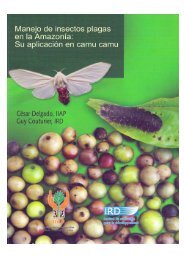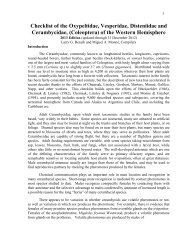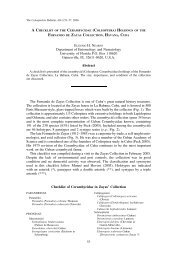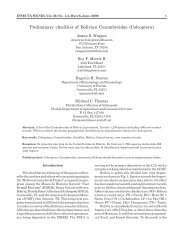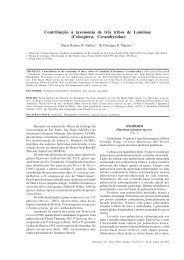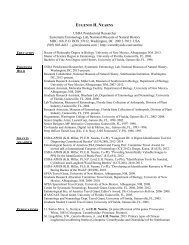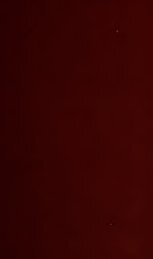Create successful ePaper yourself
Turn your PDF publications into a flip-book with our unique Google optimized e-Paper software.
44 THE TRIBE QNOIDERINI<br />
Hypsioma opalina Dillon and Dillon, spec. nov.<br />
PLATE III, FIGURE 2.<br />
From H. cha,rila, this species can be separated as follows : ely<br />
tra more attenuate apically, disk at base more coarsely punctate,<br />
humeral anterior margin neady straight, angle with tubercle ob<br />
tusely rounded j front very feebly narrowed between eyes ; and<br />
surface color of elytra olive brown.<br />
FEMALE. Elongate-ovate, rather robust, subcylindrical, ciytra convex; head<br />
and pronotum fUECOUS or piceous; eiytra dull olive-brown. Head and pronotum<br />
pale gray pubescent, varied with fulvous. Scutellum fulvous pubescent, with<br />
lateral edges narrowly gray. Elytm thinly fulvous pubescent, with numerous,<br />
small, irregular patches of pale gray, the fulvous pubescence forming a. rather<br />
indistinct, oblique fascia ncar middle. Beneath dark reddish-brown, rather thinly<br />
clothed with yellowish-white pubescence, which is interspersed with numerous small,<br />
irregular, glabrous spaces; metasternum with faint touches of fulvous; abdomen<br />
medi[llly with a broad glabrous vitta, each side of which is a very narrow<br />
whitish vitta. Leg3 dark reddish-brown, thinly clothed with yellowish-white; claw<br />
segment entirely dark brown, thinly gray pubescent on basal two-thirds. Antennae<br />
dark reddish-brown; basal two-thirds of scape and third and basal half of remain<br />
ing segments, yellowish-gray pube:cent, remaining third oj scape and third segment<br />
ancl half of other segments, dark brown pubescent.<br />
Head above finely, densely punctate, with median impressed line from occiput<br />
to near epistoma; front and genae minutely alutaceous; gena. with large, scattered<br />
and very w'allow punctures, much elongate, pubescent; eyes with lower lobe<br />
elongate-ovate, three-fourths height of gena ; antennal tubercles well separated, not<br />
produced at apex but prominent. Pronotum transverse; base wider than apex;<br />
sides straight, unarmed; with an :l.pic.'ll and basal sulcus; disk with three tubercles,<br />
median one just slightly behind middle, very small, round, one either side broad,<br />
elongate and more elevated than meciian; base with a few small granules. Scutellum<br />
transverse; sides straight, oblique; apex arcuate, notched medially. Elytra with<br />
sides nearly straight, somewhat tapering apically; apices each rounded; each with<br />
a longitudinal, rather well elevated, feebly arcuate, granulate-punctate gibbosity,<br />
remainder of surface of basal fourth granulate-punctate, thence with coafse, sparse<br />
punctures, these becoming smaller apically; humeri projecting, anterior margin<br />
strongly oblique, only feebly arcuate, and forming a broad angle with the hind<br />
margin, on whieh is a yery obtuse tubercle. Prosternum not widened behind<br />
middle; fifth sternite about twice length of fourth, at apex nearly straight, broadly,<br />
shallowly, triangularly impressed. Procoxae globose, not tubercled; profemora only<br />
Yery gradually widened apically, remaining femora more suddenly clavate. Antennae<br />
about .'IS long as body, fimbriate moderately on first to fifth segments;, scape slender,<br />
capitate apically, not quite reaching to middle of pronotum; third segment slender,<br />
sinuat.e, one-fifth longer than scape; remaining segments gradunlly shorter.<br />
LENGTH 15 mm.; width 7 mnl.<br />
Holotype.-Female ; Rio de Janeiro, Brazil; [M.C.Z.].<br />
Paratype.-Female; Brazil; [M.C.Z.].



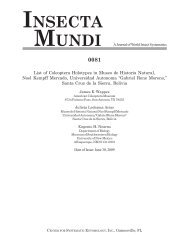
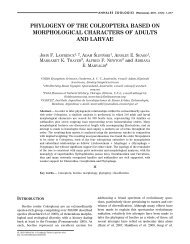


![Coleoptera. Vol. I. [Longicornia. Part I.]](https://img.yumpu.com/41202793/1/180x260/coleoptera-vol-i-longicornia-part-i.jpg?quality=85)
